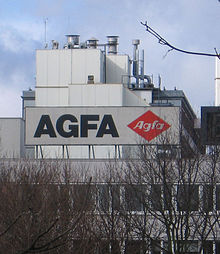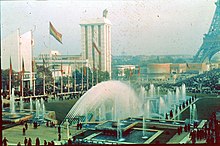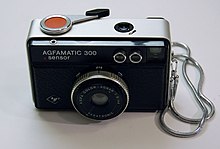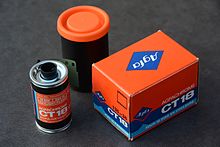
I. G. Farbenindustrie AG, commonly known as IG Farben, was a German chemical and pharmaceutical conglomerate. It was formed in 1925 from a merger of six chemical companies: Agfa, BASF, Bayer, Chemische Fabrik Griesheim-Elektron, Hoechst, and Weiler-ter-Meer. It was seized by the Allies after World War II and split into its constituent companies; parts in East Germany were nationalized.

ORWO is a registered trademark of the company ORWO Net GmbH, based in Wolfen and is also traditionally known for black-and-white film products, made in Germany and sold under the ORWO brand.

In photography, reversal film or slide film is a type of photographic film that produces a positive image on a transparent base. Instead of negatives and prints, reversal film is processed to produce transparencies or diapositives. Reversal film is produced in various sizes, from 35 mm to roll film to 8×10 inch sheet film.

Rollei was a German manufacturer of optical instruments founded in 1920 by Paul Franke and Reinhold Heidecke in Braunschweig, Lower Saxony, and maker of the Rolleiflex and Rolleicord series of cameras. Later products included specialty and nostalgic type films for the photo hobbyist market.

Agfacolor was the name of a series of color film products made by Agfa of Germany. The first Agfacolor, introduced in 1932, was a film-based version of their Agfa-Farbenplatte, a "screen plate" product similar to the French Autochrome. In late 1936, Agfa introduced Agfacolor Neu, a pioneering color film of the general type still in use today. The new Agfacolor was originally a reversal film used for making "slides", home movies and short documentaries. By 1939, it had also been adapted into a negative film and a print film for use by the German motion picture industry. After World War II, the Agfacolor brand was applied to several varieties of color negative film for still photography, in which the negatives were used to make color prints on paper. The reversal film was then marketed as Agfachrome. These films use Color Developing Agent 1 in their color developer.
The American IG Chemical Corporation, or American IG for short, was an American holding company incorporated under the Delaware General Corporation Law in April 1929 and headquartered in New York City. It had stakes in General Aniline Works (GAW), Agfa-Ansco Corporation, and Winthrop Chemical Company, among others, and was engaged in manufacture and sale of pharmaceuticals, photographic products, light weight metals, synthetic gasoline, synthetic rubber, dyes, fertilizers, and insecticides. The Moody's industrial manual listed an affiliation between IG Farben and American IG at the time of founding. First, Hermann Schmitz, who was the second after Carl Bosch in IG Farben's hierarchy, and then his brother, Dietrich A. Schmitz, served as American IG's presidents. It was re-incorporated as General Aniline & Film (GAF) Corp. in 1939 after a merger with General Aniline Works.
Rodinal is the trade name of a black and white developing agent produced originally by the German company Agfa based on the chemical 4-aminophenol. Rodinal is a popular high acutance black and white developer and is used at different dilutions for development in rotary machines, by agitation, as well as for stand development.

AgfaPhoto GmbH is a European photographic company, formed in 2004, when Agfa-Gevaert sold their Consumer Imaging division. Agfa had for many years been well known as a producer of consumer-oriented photographic products including films, photographic papers and cameras. However, within a year of the sell-off, AgfaPhoto had filed for bankruptcy.

The ADOX brand for photographic purposes has been used by three different companies since its original conception over one hundred fifty years ago. ADOX was originally a brand name used by the German company, Fotowerke Dr. C. Schleussner GmbH of Frankfurt am Main, the world's first photographic materials manufacturer. In 1962 the Schleussner family sold its photographic holdings to DuPont, an American company. DuPont used the brand for its subsidiary, Sterling Diagnostic Imaging for X-ray films. In 1999, Sterling was bought by the German company Agfa. Agfa did not use the brand and allowed its registration to lapse in 2003. Fotoimpex of Berlin, Germany, a company founded in 1992 to import photographic films and papers from former eastern Europe immediately registered the brand and today ADOX is a brand of black and white films, photographic papers and photochemistry produced by ADOX Fotowerke GmbH based in Bad Saarow near Berlin.

Ansco was the brand name of a photographic company based in Binghamton, New York, which produced photographic films, papers and cameras from the mid-19th century until the 1980s.
Wolfen is a town in the district Anhalt-Bitterfeld, Saxony-Anhalt, Germany. Since 1 July 2007 it is part of the town Bitterfeld-Wolfen. It is situated approximately 6 kilometres northwest of Bitterfeld, and 20 kilometres south of Dessau.

Harman Technology Limited, trading as Ilford Photo, is a UK-based manufacturer of photographic materials known worldwide for its Ilford branded black-and-white film, papers and chemicals and other analog photography supplies. Historically it also published the Ilford Manual of Photography, a comprehensive manual of everything photographic, including the optics, physics and chemistry of photography, along with recipes for many developers.
A chromogenic print, also known as a C-print or C-type print, a silver halide print, or a dye coupler print, is a photographic print made from a color negative, transparency or digital image, and developed using a chromogenic process. They are composed of three layers of gelatin, each containing an emulsion of silver halide, which is used as a light-sensitive material, and a different dye coupler of subtractive color which together, when developed, form a full-color image.
RA-4 is Kodak's proprietary name for the chemical process most commonly used to make color photographic prints. It is used for both minilab wet silver halide digital printers of the types most common today in photo labs and drug stores, and for prints made with older-type optical enlargers and manual processing.

Friedrich Gajewski was a Nazi German businessman with IG Farben and Wehrwirtschaftsführer during the Second World War. He was tried for war crimes for his role in the Holocaust and acquitted.

Gevacolor is a color motion picture process. It was introduced in 1947 by Gevaert in Belgium, and an affiliate of Agfacolor. The process and company flourished in the 1950s as it was suitable for on location shooting. Both the companies merged in 1964 to form Agfa-Gevaert, and continued producing film stock till the 1980s.
Lloyd E. Varden was an expert in the photographic field and related sciences. He was an adjunct Professor of Photographic Sciences and Engineering at Columbia University in New York 1951–1968.






















